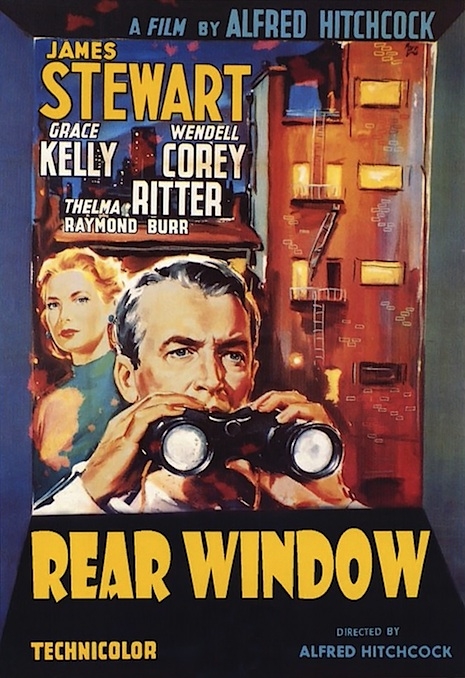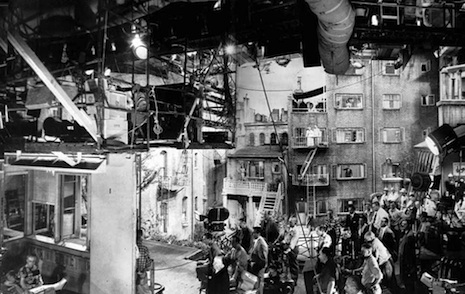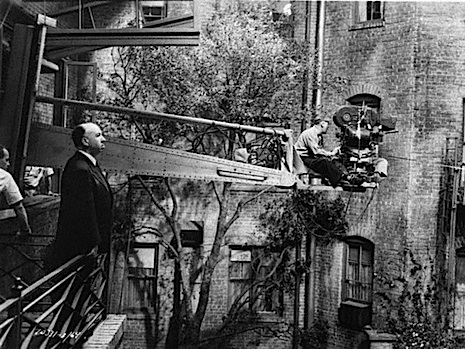
“We’ve become a nation of peeping toms,” says Thelma Ritter to James Stewart in Alfred Hitchcock’s Rear Window (1954). It’s an ironic comment in light of the events that follow—as well as offering a critique of the voyeuristic nature of cinema. Stewart plays L.B. “Jeff” Jefferies a photographer laid-up with a broken leg in his Greenwich Village apartment. He is attended to by his nurse (Ritter) and then his girlfriend Lisa Carol Fremont (Grace Kelly). Stewart spends his time spying on his neighbors watching their lives unfold. He becomes obsessed with one neighbor, Lars Thorwald (Raymond Burr), who he soon suspects of being a murderer.
Based on the short story “It Had to Be Murder” by Cornell Woolrich, Rear Window is considered by some critics as Hitchcock’s “greatest film”—“possibly his most clever, his most ingeniously organized and poetically suggestive,” as John Fawell described it in his book Hitchcock’s Rear Window:
Rear Window offers an example of Hitchcock’s art at its best, when the batteries were really charged, when form and ideas, entertainment and art, all synchronized in a particularly harmonious whole.
Hitchcock considered Rear Window (along with Psycho) to be one of his most successful experiments in “pure cinema.” The “possibility of doing a purely cinematic film,” was part of the reason Hitchcock had been attracted to Woolrich’s story, as he told French New Wave director François Truffaut:
You have an immobilised man looking out. That’s one part of the film. The second part shows how he reacts. This is actually the purest expression of a cinematic idea.
[Soviet film director Vsevolod] Pudovkin dealt with this, as you know. In one of his books on the art of montage, he describes an experiment by his teacher, [Lev] Kuleshov. You see a close-up of the Russian actor Ivan Mosjoukine. This is immediately followed by a shot of a dead baby. Back to Mosjoukine again and you read compassion on his face. Then you take away the dead baby and you show a plate of soup, and now, when you go back to Mosjoukine, he looks hungry. Yet, in both cases, they used the same shot of the actor; his face was exactly the same.
In the same way, let’s take a close-up of Stewart looking out of the window at a little dog that’s being lowered in a basket. Back to Stewart, who has a kindly smile. But if in place of the little dog you show a half-naked girl exercising in front of an open window, and you go back to a smiling Stewart again, this time he’s seen as a dirty old man!
Indeed Woolrich’s story suggested many of the set-pieces contained in Hitchcock’s movie—from being focussed on the central character’s point of view, to his observations of the neighbors across the way. Woolrich’s biographer, Francis M. Nevins, considered the film as “simply a translation of the story’s material in visual terms.” He also described Woolrich and Hitchcock as “soul brothers” (though author and director never met) claiming both were haunted by their Catholic upbringing and shared a sense (as Nevins puts it) of “humans as creatures trapped in the habits of their existence.”
Rear Window was shot entirely at Paramount Studios, where the set of an enormous apartment block for Stewart’s neighbors was built that (as Truffaut described it) offered “intentionally or not… an image of the world.” Hitchcock agreed:
It shows every kind of human behaviour—a real index of individual behaviour. The picture would have been very dull if we hadn’t done that. What we see across the way is a group of little stories that, as you say, mirror a small universe.
This fine selection of photographs shows Hitchcock on set directing James Stewart and Grace Kelly in one of cinema’s greatest voyeuristic thrillers Rear Window.



More behind-the-scenes photos from ‘Rear Window,’ after the jump…





